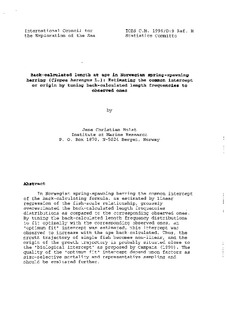| dc.contributor.author | Holst, Jens Christian | |
| dc.date.accessioned | 2012-09-26T14:08:05Z | |
| dc.date.available | 2012-09-26T14:08:05Z | |
| dc.date.issued | 1996 | |
| dc.identifier.citation | This report is not to be cited without prior reference to the author | no_NO |
| dc.identifier.uri | http://hdl.handle.net/11250/105550 | |
| dc.description.abstract | In Norwegian spring-spawning herring the common intercept
of the back-calculating formula, as estimated by linear
regression of the fish-scale relationship, grosssly
overestimated the back-calculated length frequencies
distributions as compared to the corresponding observed ones.
By tuning the back-calculated length frequency distributions
to fit optimally with the corresponding observed ones, an
"optimum fit" intercept was estimated. This intercept was
observed to increase with the age back-calculated. Thus, the
growth trajectory of single fish becomes non-linear, and the
origin of the growth trajectory is probably situated close to
the "biological intercept" as proposed by Campana (1990). The
quality of the "optimum fit" intercept depend upon factors as
size-selective mortality and representative sampling and
should be evaluated further. | no_NO |
| dc.language.iso | eng | no_NO |
| dc.publisher | ICES | no_NO |
| dc.relation.ispartofseries | ICES CM Documents;1996/D:9 | |
| dc.subject | herring | no_NO |
| dc.subject | sild | no_NO |
| dc.subject | distribution | no_NO |
| dc.subject | utbredelse | no_NO |
| dc.title | Back-calculated length at age in Norwegian spring-spawning herring (Clupea harengus L.) : Estimating the common intercept or origin by tuning back-calculated length frequencies to observed ones | no_NO |
| dc.type | Working paper | no_NO |
| dc.subject.nsi | VDP::Agriculture and fishery disciplines: 900::Fisheries science: 920::Resource biology: 921 | no_NO |
| dc.subject.nsi | VDP::Agriculture and fishery disciplines: 900::Fisheries science: 920::Fish health: 923 | no_NO |
| dc.source.pagenumber | 24 s. | no_NO |
